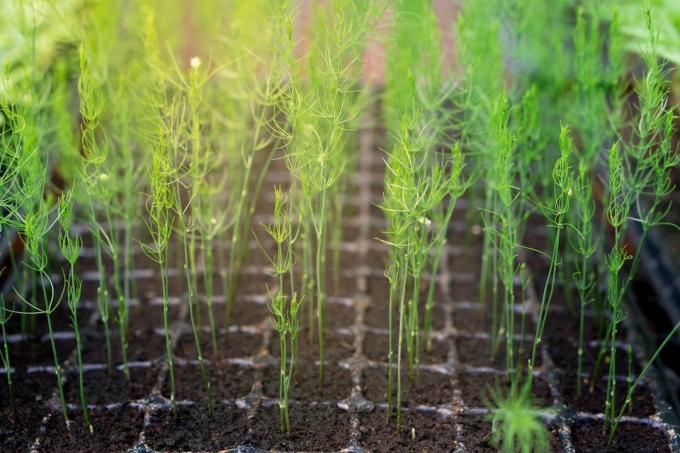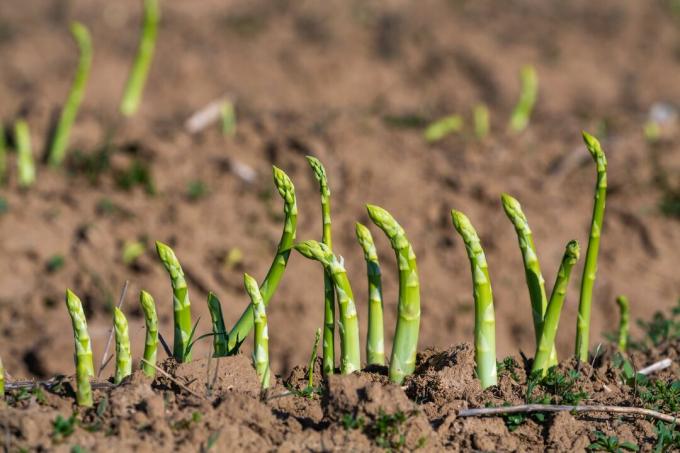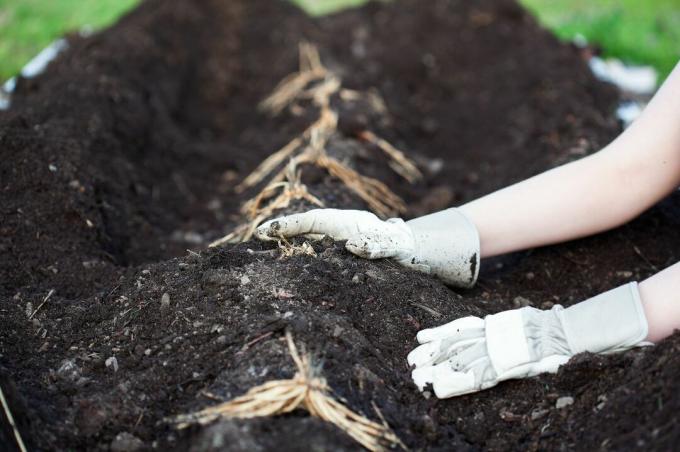Green and white asparagus are popular in spring. You can also plant them in your own garden. We give tips on creating an asparagus plant.
the asparagus (Asparagus officinalis) inspires gourmets worldwide. What many hobby gardeners don't know: with a little skill, you can also grow these delicate and expensive vegetables in your own garden. You can buy seeds or rhizomes from young plants in selected online shops. When buying asparagus plants, however, it is better to leave the inner savings growth at home, because the quality of the plants is decisive for later success.
contents
- Buy seeds or young plants
- Choose the right location and soil for asparagus
- plant asparagus
- Fertilize asparagus properly
Buy seeds or young plants
Professional asparagus farmers usually use rhizome plants, a smaller proportion buys seeds and uses them to grow plants in soil pressure pots in the greenhouse. Buying seeds to grow in pots is cheaper, but at the same time means more effort and a year longer cultivation time. If you decide to use seeds, this means that you have to wait at least three years before the first harvest, then approx. four weeks to be harvested. With rhizome plants, a short harvest of approx. 10-14 days and after two years it can already be approx. Harvest for 4 weeks.

Start sowing in the spring on your own windowsill. The sowing depth is about 1cm. With a height of about 10cm, the asparagus seedlings are pricked out and placed in a slightly larger pot. The young asparagus plants can then be planted in the garden in mid to late May.
Young green and white asparagus plants can also be bought online. Here, in the spring, rhizomes are mostly supplied by annual plants. The quality of the rhizome is extremely important. Asparagus with rotten or rotten roots is rarely an option. This also unnecessarily delays the already long waiting time until the first harvest.
Choose the right location and soil for asparagus
Asparagus makes certain demands on the soil. In the best case, the soil is deep rootable, deep (40-60cm deep topsoil layer) and free of roots and stones. Asparagus plants love water and air-permeable soils that warm up quickly in spring. Heavy and poorly aerated soils in combination with a shady location often lead to rot. Waterlogging is also a knockout criterion for asparagus cultivation.

The nutrient content is just as important as the composition of the soil. If you plan to plant asparagus in the long term, the soil should be prepared a year before planting. In order to increase the nutrient content, well-rotted manure, compost (up to 10 liters per square meter) and humus can be piled up at the planting site and worked in. If this is done a year before the asparagus is planted, green manure can also be applied directly. By this, the expert understands the planting of plants such as oil radish or yellow mustard. This is mixed into the soil on the spot in autumn, rots and thus releases important nutrients into the soil.
If your own planning horizon is shorter and the asparagus is to be planted directly, it is best to dig a trench that is 30 cm deep and just as wide for planting. This is filled with about 10cm of manure and compost. At the same time, 200g each of phosphorus and potash can also be added.
plant asparagus
If you have high-quality asparagus rhizomes or well-established seedlings from your own cultivation, you can finally get started. Planting time for the rhizomes is usually between the beginning of April and mid-May, the seedlings are then planted after the ice saints in mid-May. The soil should already be warm and not too wet, this creates ideal, vigorous conditions for the young plant. In cold and wet soil, the plants remain and damaged areas on the storage roots easily begin to rot. Plant green asparagus about 15 cm deep, white asparagus up to 25 cm. The individual storage roots should be carefully spread out in a fan shape in the bottom of the ditch. Immediately after planting, cover the roots with 8-10cm of soil. As the plant grows, fill the trench piece by piece with soil.

The same applies to self-sown plants. These are planted in a wide trench at the desired depth later. Gradually add soil towards autumn, this gives the new shoots support and spills germinating weeds. The planting depth has an impact on how many years a white asparagus plant can be harvested. Because the root system of the plants not only grows in depth and width over the years, but also upwards. The deeper the plants are planted, the longer white asparagus can potentially be harvested. However, the harvest starts later and later and it is more difficult for the young plants to establish themselves at the location. As the plants grow taller over the years, the dam also has to get higher and higher To be able to harvest white asparagus with a sufficient length and not to damage the asparagus plant when pricking hurt. But at some point, of course, the end of what is possible will be reached here too, and the poles will become weaker after a while Thinner and thinner over the years, so that with good cultivation management, an asparagus plant can be expected to last 8-10 years can.

You need about 3 asparagus plants per meter. More modern varieties require slightly higher densities. The distance between the rows is 1 to 1.5 m for green asparagus, while white asparagus requires at least 1.5 to 1.6 m (if only because of the amount of soil for the dam). The distance between the asparagus plants is about 25-33cm. In contrast to white asparagus, staggered planting in double rows is ideal for green asparagus. Thus, a plant in the row is exactly between two plants in the other row. If you plant in double rows, the distance between the individual rows is approx. 15-30 cm, the distance between the double rows should be at least 1.5 meters for better ventilation of the plants.
Fertilize asparagus properly
Asparagus can be grown in the home garden for up to ten years in the same location. However, this sets a good ground, a well-adjusted Asparagus fertilization and a muted harvest ahead. In the best case scenario, the soil is treated with a primarily organic organic fertilizer such as our Plantura in the autumn of the year before planting Organic universal fertilizer improved. Compost or green manure is then used during the season. In late autumn, after removing the asparagus leaves, an organic fertilizer with a long-term effect should be worked in again. You can also do it every three years liming. Depending on the type of soil, the pH should be between 5.8 and 6.5.
After successful cultivation, you can look forward to a rich asparagus harvest. In our special article you will find all information about Harvesting and storage of asparagus.
